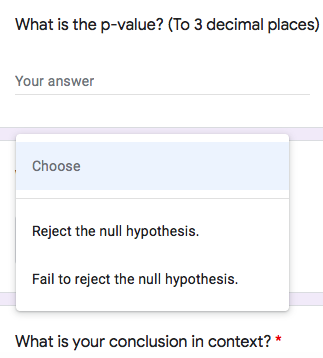If there is no seasonal effects on human births, we would expect equal numbers of children to be born in each season (winter, spring, summer, and fall). A student takes a census of her statistics class and finds that of the 120 students in the class, 25 were born in winter, 35 in spring, 32 in summer, and 28 in fall. She wonders if the excess in the spring is an indication that births are not uniform throughout the year. What is the chi-square statistic? What is the p-value? ( 3 decimal places) What is your decision? What is your conclusion in context?
If there is no seasonal effects on human births, we would expect equal numbers of children to be born in each season (winter, spring, summer, and fall). A student takes a census of her statistics class and finds that of the 120 students in the class, 25 were born in winter, 35 in spring, 32 in summer, and 28 in fall. She wonders if the excess in the spring is an indication that births are not uniform throughout the year. What is the chi-square statistic? What is the p-value? ( 3 decimal places) What is your decision? What is your conclusion in context?
Algebra & Trigonometry with Analytic Geometry
13th Edition
ISBN:9781133382119
Author:Swokowski
Publisher:Swokowski
Chapter10: Sequences, Series, And Probability
Section10.8: Probability
Problem 31E
Related questions
Topic Video
Question
If there is no seasonal effects on human births, we would expect equal numbers of children to be born in each season (winter, spring, summer, and fall). A student takes a census of her statistics class and finds that of the 120 students in the class, 25 were born in winter, 35 in spring, 32 in summer, and 28 in fall. She wonders if the excess in the spring is an indication that births are not uniform throughout the year.
What is the chi-square statistic?
What is the p-value? ( 3 decimal places)
What is your decision?
What is your conclusion in context?

Transcribed Image Text:What is the p-value? (To 3 decimal places)
Your answer
Choose
Reject the null hypothesis.
Fail to reject the null hypothesis.
What is your conclusion in context? *

Transcribed Image Text:If there is no seasonal effects on human births, we would expect equal
numbers of children to be born in each season (winter, spring, summer, and
fall). A student takes a census of her statistics class and finds that of the 120
students in the class, 25 were born in winter, 35 in spring, 32 in summer, and 28
in fall. She wonders if the excess in the spring is an indication that births are
not uniform throughout the year.
Expert Solution
This question has been solved!
Explore an expertly crafted, step-by-step solution for a thorough understanding of key concepts.
This is a popular solution!
Trending now
This is a popular solution!
Step by step
Solved in 2 steps with 5 images

Knowledge Booster
Learn more about
Need a deep-dive on the concept behind this application? Look no further. Learn more about this topic, statistics and related others by exploring similar questions and additional content below.Recommended textbooks for you

Algebra & Trigonometry with Analytic Geometry
Algebra
ISBN:
9781133382119
Author:
Swokowski
Publisher:
Cengage

Holt Mcdougal Larson Pre-algebra: Student Edition…
Algebra
ISBN:
9780547587776
Author:
HOLT MCDOUGAL
Publisher:
HOLT MCDOUGAL

Glencoe Algebra 1, Student Edition, 9780079039897…
Algebra
ISBN:
9780079039897
Author:
Carter
Publisher:
McGraw Hill

Algebra & Trigonometry with Analytic Geometry
Algebra
ISBN:
9781133382119
Author:
Swokowski
Publisher:
Cengage

Holt Mcdougal Larson Pre-algebra: Student Edition…
Algebra
ISBN:
9780547587776
Author:
HOLT MCDOUGAL
Publisher:
HOLT MCDOUGAL

Glencoe Algebra 1, Student Edition, 9780079039897…
Algebra
ISBN:
9780079039897
Author:
Carter
Publisher:
McGraw Hill